Squirrels are at their most busiest during this month as they search and hide as many nuts and seeds as possible to store for winter. It is the perfect time to get out there and draw them. With their busy tails, they have to be one of the fluffiest things I have ever drawn. It can be challenging to draw something fluffy without fluffing it up in the process.
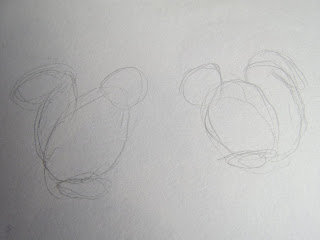 |
| Stage One |
There are two species of squirrel living in the UK, the native red and the non-native grey. I will show you how to draw both of them. On the left will be the red and on the right will be the grey. The basic shapes for both of them is a circle for the head, an oval for the body, 2 ovals make up the tail and a smaller one for the hind paw.
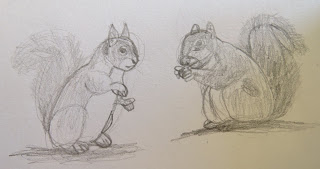 |
| Stage Two |
Next, I reshape the head by adding the muzzle, ears, eyes and other features. I create tiny shapes to help map out where everything is and I shade in these tiny shapes to create fur. This method also helps mold the general outline to the way I want it. For the legs, draw a rough series of two to three round shapes. On the front legs, the first shape represents the shoulder to 'elbow' and is slightly bigger than the second one, which joins to the smallest shape, the paw. The hind legs are made up of two shapes, the paw (which you have done already) and a large circle. Once you have drawn the legs, add toes and shade in the fur. The tails are actually fun to do. Start from the base of the tail and create a series of lined scribbles sreading outwards and creating a fluffy appearance. The grey squirrel has some dark markings in its fur, while the red has pointy ears and a bright white belly.
 |
| Stage Three |
I wasn't happy with my overall appearance on their heads while drawing in pencil, but now it is time to improve them as I redraw in pen. But I don't draw over the outline and shade in, instead I do the reverse. Starting from the ears, I begin to create the fur by building areas with layers of tiny lines, which also help build the overall outline. I take careful care and planning as I go to the eyes, snout and pale patches in the fur. The whole body and tail of both squirrels are given the same treatment. Darker areas of fur is shaded in more heavily than lighter areas. Don't forget to add the whiskers after you complete the fur.
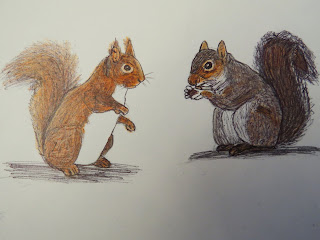 |
| Stage Four |
The big difference between the two species is their colour. For my red squirrel, I use orange (not red) and a bit of brown. I used two different shades of orange, a light and a dark. Go lightly around much of the tail. For my grey squirrel, I used orange, brown and grey and I used the pen to go over some parts as a highlight. Leave the edging of the tail as pale as you can.
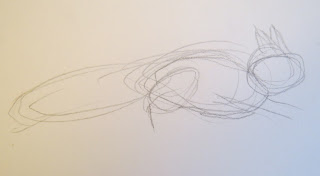 |
| Stage One |
Squirrels are expert climbers and can move through the trees with ease. When it comes to moving squirrels, the basic shapes are repositioned into the posture you want. You can straighten or curve the tail and point it into any direction. The body can be arched when jumping or flattened with limbs spread outwards on either side when climbing a tree trunk. It is up to you to what the squirrel is doing. I will be drawing a jumping red squirrel with the tail straight, the hind legs pointing back and the front legs pointing foward.
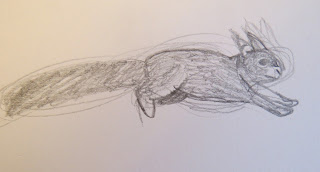 |
| Stage Two |
As before, create tiny shapes to mold the main outline and to work out where each feature goes where and shade in these tiny shapes to create the fur. The tail is less fluffy while it is straight when jumping.
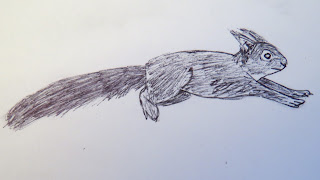 |
| Stage Three |
With a pen, shade in the fur, repositioning the general shape as you go.
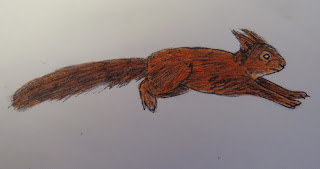 |
| Stage Four |
Colour your squirrel in...
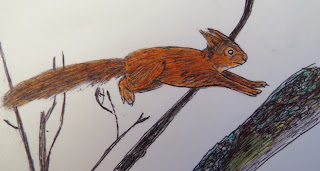 |
| Stage Five |
... then add the branches in. If you are drawing a climbing squirrel, the legs on the other side are not drawn as you draw the branch between them. On a tree trunk, however, all four legs are shown if the back of the squirrel is facing in your direction.
And that is how to draw squirrels. Whether you are drawing a red or a grey squirrel or one of the many other species across the world, have fun and play around with the many positions and postures they make as they move around. Squirrels are great subjects to both watch and draw, so why not get out there and enjoy them no matter what colour they are.









Love this Sean. You are very talented!
ReplyDelete